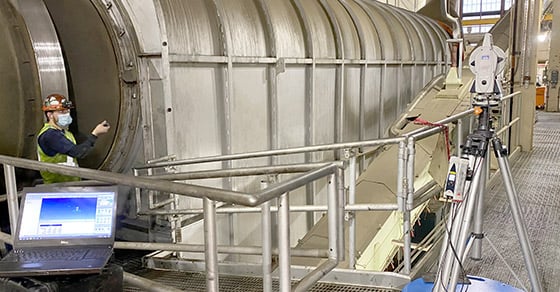Recent advancements have made rotary kiln alignment methods faster and more effective than ever.
Misalignment is one of the most common (and most treatable) causes of rotary kiln damage. Alignment touches all components of a rotary kiln, with misalignment promoting wear on all parts. In addition to increased wear, problems resulting from misalignment have the potential to escalate into major damage and even premature equipment failure, making proper kiln alignment a top priority.
Improved Rotary Kiln Alignment Methods
Routinely inspecting your rotary kiln to assess alignment should be part of your regular maintenance program in order to maintain operational efficiency and prolong the life of the kiln. Any alignment issues should addressed promptly.
Many kiln alignment methods exist on the market today. However, they all work to achieve the same goal: align the trunnion wheels with the centerline of the drum in accordance with the overall slope of the drum. This ensures that the entire load of the kiln is distributed evenly across all components, promoting balanced, efficient operation and the least amount of wear possible.
Rotary kiln alignment methods have come a long way in the recent past. The traditional method of alignment involves hand measuring various points and then using a variety of calculations to determine the adjustments needed. This process is effective, but slow, and ripe with potential for error.
Although this method is still widely used today, new laser tracking systems have taken alignments to a new level, making precision alignment faster and more accurate than ever before.
Laser tracking systems use laser beams to establish a 3D spatial map of the equipment. Used with state-of-the-art software programs, this method of alignment offers precision results in significantly less time with greatly reduced potential for error.
When Kiln Alignment is Needed
Rotary kilns can fall out of alignment for a number of reasons. Kiln misalignment could be a result of structural issues such as sinking foundations, shifting steel, or processing environment issues such as the amount of humidity or even dust in the air.
The myriad of reasons for which a kiln can fall out of alignment can make misalignment difficult to predict. For this reason, regular inspections should be performed by on-site personnel to catch any signs of misalignment at their onset, before they have a chance to escalate. Annual inspections should also be performed by the original equipment manufacturer or other qualified service provider. Recording any misalignment issues and how they were treated is best practice and can be useful in helping to predict future alignment issues and treatment methods.
Alignment is also necessary at installation. During installation, care must be taken to account for the hot kiln load; a hot kiln under operational load will behave much differently than a cold, empty kiln. Aligning a cold kiln without taking into account the thermal stresses and operational load of production conditions can result in a misaligned kiln from the start.
In addition to alignment at install, kilns should also be realigned after any major components, such as trunnion wheels, have been replaced or resurfaced, as this can cause the kiln to fall out of optimal alignment.
Furthermore, if process conditions have changed, the kiln may also require realignment. Because the kiln was designed and aligned for specific operating parameters, a change in conditions will likely require realignment.
Signs that a Rotary Kiln is Out of Alignment:
There are many signs that can potentially indicate when a kiln is out of alignment. It’s important to note that these signs could be indicative of other issues as well, and only a trained professional can determine the true cause of a given problem. Signs that a kiln is out of alignment can include:
- Wear after tire or trunnion surfaces have been recently repaired/resurfaced.
- Chattering or vibrational noises
- Excessive wear or damage to the tire/wheel
- Excessive wear or damage to the thrust roller
- Excessive wear or damage to the pinion/girth gear
How the Rotary Kiln Alignment Process Works:
FEECO Customer Service Engineers are highly skilled in assessing and performing alignments using the latest techniques in rotary kiln alignment, including the use of a laser tracking system. The typical FEECO rotary kiln alignment method follows this progression:
Step One: Observe the Drum.
The Customer Service Engineer will observe the drum under normal operating conditions. During this time, the engineer will examine a number of factors that can indicate the alignment of the kiln, the overall health of the kiln, and to what extent misalignment has potentially affected the system thus far. This will likely include observing:
- Auditory abnormalities such as chattering or grinding noises
- Visual abnormalities or signs of wear on shell, tires, trunnion wheels, thrust rollers, girth gear or other drive components, etc.
- Contact points such as thrust rollers, trunnion wheels, gear mesh and grease pattern, etc.
Step 2: Shut Down the Kiln and Gather Positioning Data
The Customer Service Engineer will then ask for the drum to be shut down in order to perform the data collection part of the process. Performing the alignment while the kiln is shut down and locked out ensures a safe working environment is established.
A laser tracking unit is positioned at various points along the kiln. The tracker communicates with a base from the various positions to establish spatial coordinates and develop a 3D model of the kiln. Diameter and face profiles of tires and trunnions give a detailed picture of the kiln’s positioning. This is all tracked and recorded using advanced software.
Step 3: Analyze the Results
Once all measurements have been taken, the engineer can begin to analyze the results.The software program visualizes the rotary kiln and the corresponding measurements so the engineer can see exactly where and how much adjustment is needed.
Step 4: Adjustment
Once the engineer has determined where and how much adjustment is needed, there are two options for adjustment to achieve proper alignment: shimming and skewing.
Shimming involves adding “shims,” or metal plates, under trunnion bearings in order to adjust the elevation of the trunnions. Shims are available in varying heights to accommodate any amount of adjustment needed.
Skewing is carried out by moving the bearings in or out in order to align the trunnion with the centerline of the drum. Unlike shimming, this method does not require the drum or trunnion wheels to be lifted. In some situations, it may be necessary to use both techniques to achieve proper alignment.
Step 5: Perform Drum Training to Achieve Proper Float
Float refers to the positioning of the drum between thrust rollers. Thrust rollers prevent the drum from drifting by riding on the downhill and uphill edges of the tire with little-to-no contact with the riding ring/tire. The thrust rollers are mounted with about ¼” of tolerance from the tire. The drum should ride evenly between the thrust rollers, not pushing harder on one than the other. Drum training is done by skewing the trunnion bearings until proper float is achieved.
Advantages to a FEECO Kiln Alignment
In addition to our state-of-the-art laser tracking alignment system, there are a number of advantages to having a FEECO Customer Service Engineer perform rotary kiln alignment:
Complete System Integration: Unlike many rotary kiln service providers that look at components in isolation, the FEECO method of alignment looks at how the various components (trunnion wheels, bearings, thrust rollers) perform together as a whole.
Hassle-Free Alignment: While other service providers may require the surrounding support equipment to be moved, FEECO Customer Service Engineers can often perform an alignment on a rotary kiln in place, because of our ability to measure coordinates around support equipment such as plumbing or electrical components. Our system allows us to develop a spatial map of the system and supporting equipment without the hassle of having to clear the area.
Detailed Reports: FEECO also provides a detailed report of the alignment, including the state of the kiln before and after the alignment. This provides valuable benchmark data for monitoring the overall health of the kiln, as well as a starting point for future alignments.
Unmatched Rotary Kiln Expertise: Perhaps the greatest advantage to working with FEECO for alignment is that we’re not just experts in alignment; we’re experts in inspecting, diagnosing, and treating all aspects of a rotary kiln. For example, one may suspect a misalignment issue, when really the damage is related to thermal expansion issues, sinking foundations, or other factors. FEECO can inspect your kiln and diagnose any mechanical or operational failures, and then resolve those issues. Customer Service Engineers can also perform a variety of other drum health checks while on site, including:
- Drum Shell Thickness Tests
- Coupling and Shaft Alignments
- Refractory Inspections
- Seal Inspections
- Backlash Inspections
- Burner Inspections
Conclusion
Rotary kiln alignment methods have come a long way in the recent past, making alignments faster and more precise than ever before. Routine inspections and realignment (in the event of misalignment) should be a part of your regular maintenance program in order to keep your kiln running efficiently for years to come.
The FEECO Customer Service Team can inspect, diagnose, and treat any issues you may be experiencing with your rotary kiln, including misalignment, no matter what brand of equipment you have.
For more information on our precision rotary kiln alignments, contact us today!



